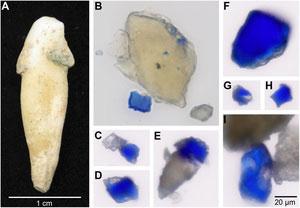Medieval Female Scribes Revealed by Blue-Flecked Teeth

Blue particles observed embedded within archaeological dental calculus.
It's not often that we hear breaking news about medieval manuscripts or, more especially, women's role in manuscript production. But here we are! In a fascinating (and open-access) article published yesterday in the journal Science Advances, researchers have concluded that the rare blue pigment known as ultramarine, being present in the dental plaque of an 11th- or 12th-century nun's skeleton unearthed in rural Germany, provides proof of women's work on illuminated medieval manuscripts. Specifically, it is suggested, the women acted as painters and illuminators -- painting and licking the tip of the brush, according to Monica Tromp, study co-author and microbioarchaeologist at the Max Planck Institute for the Science of Human History.
Ultramarine, made from the lapis lazuli stone, is "rare and expensive as gold," the researchers note in the article. "Within the context of medieval art, the application of highly pure ultramarine in illuminated works was restricted to luxury books of high value and importance, and only scribes and painters of exceptional skill would have been entrusted with its use."
They go on to conclude, as summarized in the article's abstract, that "The early use of this pigment by a religious woman challenges widespread assumptions about its limited availability in medieval Europe and the gendered production of illuminated texts."
More on this story in the Atlantic, CNN, and the New York Times.















